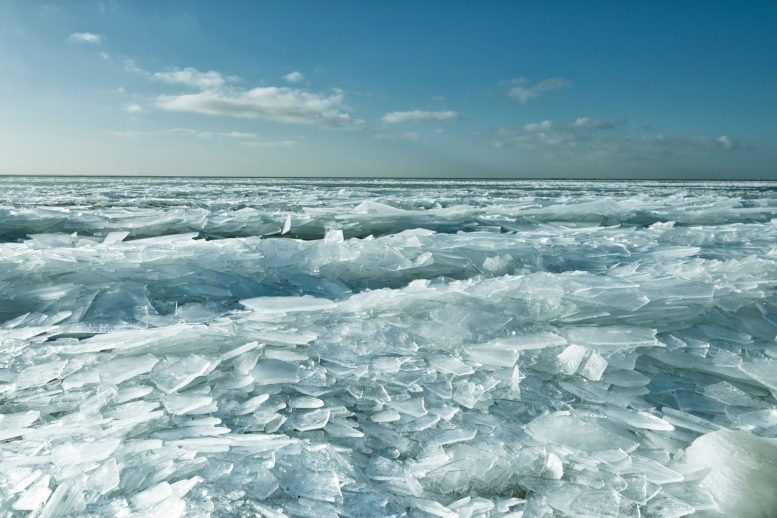
Recent field observations in Antarctica reveal that meltwater ponds are causing significant flexing and fracturing of ice shelves, suggesting that increased melting from climate change may accelerate the collapse of these critical structures, potentially raising global sea levels.
An Antarctic expedition has found that increased temperatures from climate change are causing ponds that weaken ice.
A team of scientists who installed instruments on an Antarctic ice shelf discovered that meltwater ponds were causing the ice to flex and fracture.
Though scientists had predicted the phenomenon, this was the first time it was observed in the field.
The finding raises concerns that, as climate change progresses and more melting occurs, vulnerable ice shelves in Antarctica will collapse—contributing to global sea rise.
“Ice shelves are extremely important for the Antarctic Ice Sheet’s overall health as they act to buttress, or hold back, the glacier ice on land,” said Alison Banwell, a scientist in the Cooperative Institute for Research in Environmental Sciences (CIRES) at the University of Colorado Boulder and lead author of the study published May 4 in the Journal of Glaciology. “Scientists have predicted and modeled that surface meltwater loading could cause ice shelves to fracture, but no one had observed the process in the field, until now.”
“It’s looking very likely that this process explains the collapse of the Larsen B Ice Shelf,” added Doug MacAyeal, University of Chicago Prof. Emeritus of Geophysical Sciences and co-author on the paper—referring to a notorious 2002 event in which more than 1,000 square miles of Antarctic ice collapsed into the ocean in a matter of weeks.
Around the continent of Antarctica, thick sheets of floating glacier ice extend out over the ocean. Known as ice shelves, they are thought to help keep inland glaciers stable—but more and more seem to be collapsing.
Field Research and Observational Challenges
In 2019, a group of researchers led by Banwell traveled to the George IV Ice Shelf, thought to be one of the at-risk ice shelves in Antarctica. They placed time-lapse cameras and GPS sensors to monitor the ice over the course of a year, throughout the seasonal cycle of freezing and thawing.
The outbreak of COVID-19, however, meant it was more than a year before they could return. When they returned in late 2021, several of the stations had been lost. Fortunately, some instruments survived—and they had documented a lot of evidence.
According to the research, here’s how the process works. Warmer air temperatures cause the top layers of ice on the ice shelf to melt. The newly liquid water forms a pool, which concentrates the weight in one area. Then, as anyone who’s tried to cup water in their hands knows, the water will find its way down through even the tiniest crack.
The water trickling down widens the cracks in the ice, like cracks spreading from a pothole in the road over time. Over the course of the summer, the pools fill and then drain, over and over; the GPS sensors placed atop the ice shelf recorded that the ice shelf was dropping and rising by about a foot each time. This further weakens the ice.
Ice is structurally fragile, MacAyeal said; “It’s like a weak form of glass.”
Eventually, the dam breaks. The GPS stations recorded a very sudden altitude change—meaning the ice had fractured.
The researchers said it was likely this thawing and freezing cycle was a key factor in the collapse of the Larsen B Ice Shelf in 2002, the largest ice shelf breakup on record. Before the event, satellites had recorded many pools of meltwater atop the ice shelf.
Global sea levels have risen by eight to nine inches since 1880, and the trend is accelerating over time. The melting of Antarctic ice is a major factor, and scientists worry that the loss of the ice shelves will further destabilize the situation.
“These observations are important because they can be used to improve models to better predict which Antarctic ice shelves are more vulnerable and most susceptible to collapse in the future,” Banwell said.
Reference: “Observed meltwater-induced flexure and fracture at a doline on George VI Ice Shelf, Antarctica” by Alison F. Banwell, Ian C. Willis, Laura A. Stevens, Rebecca L. Dell and Douglas R. MacAyeal, 3 May 2024, Journal of Glaciology.
DOI: 10.1017/jog.2024.31









“… vulnerable ice shelves in Antarctica will collapse—contributing to global sea rise.”
The floating ice is already displacing a volume of water equal to the melting ice; therefore, there will be no increase in sea level from the floating shelf ice melting.
“Ice shelves are extremely important for the Antarctic Ice Sheet’s overall health as they act to buttress, or hold back, the glacier ice on land,”
One commonly reads this claim. However, I have not seen a good defense of the claim. On the contrary, the tension cracks beyond the grounding line, along which large icebergs detach, strongly suggests little or no buttressing. Personally, I find the claim poorly supported. The rate of motion of a glacier is the net result of the slope of the bedrock, pressure from up-slope ice, and the basal friction with the bedrock. Any resistance provided by a ridge at the grounding line depends on the depth of the ridge and its composition. If it is a former terminal moraine, the glacier probably just bulldozes it away, with the resistance being a small fraction of what the glacier experiences up-slope. It it is a bedrock ridge, like a volcanic dike, the ice is likely to just shear over the top, as it often does before it enters the ocean. The shear strength of ice is the limiting factor in forward motion.
This is speculative scare-talk, unsupported by probability estimates and the associated uncertainty envelope. I’m left with the impression that these speculators, despite having PhDs, have the mindset of a technician rather than an actual scientist, who characteristically says something to the effect, “That is strange! I wonder why that happened?”
Such negative, pessimistic and fearful people using that fear to further themselves.
It was -77C April 27, 2024 and days later in that same blizzard it got to -80C. No ice melting without the aid of underice volcanoes. Note CO 2 freezes at -78C.